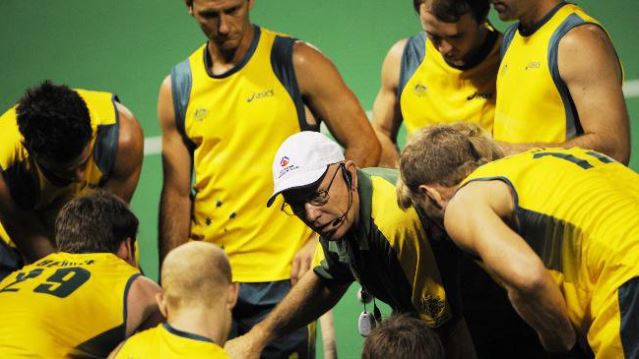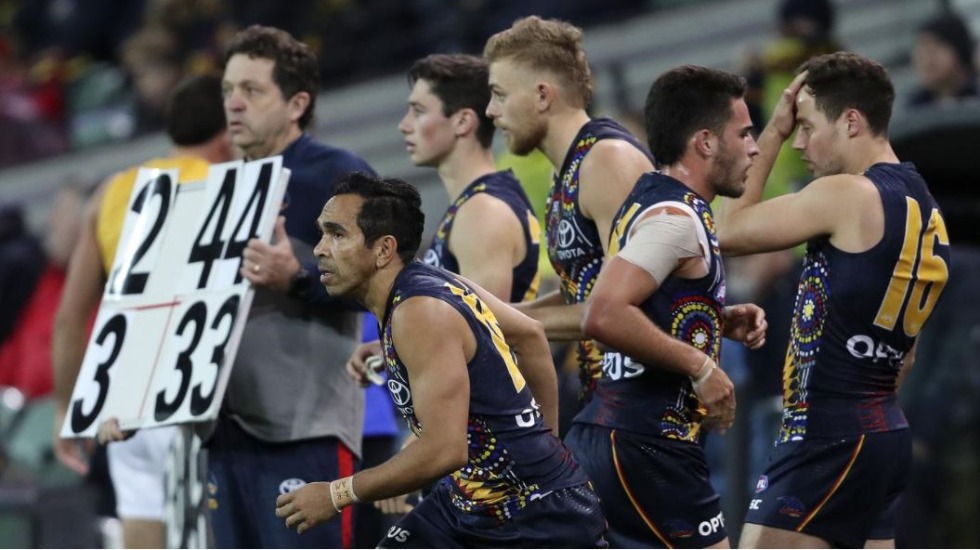Eddie Betts returns to the field from a busy Adelaide interchange bench during a game in 2019. Photo: AFL MEDIA
Opinionists, unlike umpires, can – and will – change their minds.
After a decade watching countless AFL matches and other sports that endorsed interchange rotations (or rolling substitutes, as some games call the seemingly endless swinging from the bench), it is time to concede. And to radically advocate a return to the good ol’ days with reserves.
With more evidence to digest, a critical real moment or two in a game rather than theory on the whiteboard, a rethink on the seemingly endless data, and an opinion can swing faster than the speed of light. And travel just as far as the sun’s rays too, ultimately reaching the opposite extreme in the debate.
It is that way with Australian football’s interchange rule – the now tactical lever AFL coaches use to rotate 22 players across 18 roles (rather than positions) on the football field.
Until 2014, this system was uncapped. Coaches turned the interchange gate into a revolving door that swung harder and faster than entries to department stores during the Boxing Day sales. At Adelaide in 2014, Crows coach Brenton Sanderson was having the AFL interchange steward mark down as many as 151 rotations in a match – more than one per minute.
And who has not questioned why a forward needs to sprint to the bench – burning energy – after kicking a goal?
In 2010, then AFL football chief Adrian Anderson – acting on policy direction from the AFL Commission – put everyone on notice: interchange rotations needed to be controlled.
The commission argued – perhaps without conviction out of concern for the backlash, particularly from coaches – that uncapped interchange rotations had increased the speed of the game; and with heavier and stronger-built full-time players, the injury rate from collisions was increasing.
Anderson declared in May 2010 that this was “undeniable”. He spoke of a “trend” – “the overall injury incidence has continued to increase and is at its highest rate in 10 years.”
The contrary view was – and remains – a cap on the interchange rotations would also increase injuries, in particular soft-tissue leg injuries among players kept on their feet and driven to exhaustion.
Turns out that both models create increased injury rates. The game is brutally demanding of bodies. Full stop.
Where the AFL failed in its messaging during 2010 – quite surprising considering its reputation for shaping opinion in football circles where it is not short of mouthpieces – was in not highlighting how the rising interchange rotations were exposing AFL players to a greater risk with concussion. This was the chilling takeaway note for the AFL commissioners from the injury data.
If only they had shared.
Perhaps the well-paid lawyers on retainer at AFL House warned against making any public declaration on concussion, particularly when this looms – as highlighted in the American football NFL equivalent – as a nightmare, both in financial pay-outs and long-term physical and mental health issues to players.
Anderson emphasised “hamstring injury incidence has continued to increase over the past four to five years (to 2010) and is now at its highest for some time”.
Those of us on the opposition benches responded: “But won’t fatigue set in with capped interchange rotations and lead to more soft-tissue injuries?”
Indeed it would, particularly with calf strains. The league’s detailed injury report pre-empted this, too, with capped rotations. The AFL Commission faced two evils – increased risk of concussion with uncontrolled interchange rotations, and increased leg injuries, particularly to the calf, with interchange caps.
Faced with these two conclusions, it is not surprising the cap was introduced.
“The laws of the game,” said Anderson, “say that it is a fundamental obligation of the AFL to try to assist in reducing injury for AFL players in so far as is practical in a body contact sport. We believe that’s a very important responsibility for the AFL.
“We won’t shirk or shy away from the responsibility we have to look after our plate at all levels.”
If only Anderson – and the AFL – had been firmer in detailing the concussion issue with rising interchange rotations (and the collision rates and speed factor in the 21st century game).
Now the history lesson to add perspective.
Interchange was introduced to Australian football in 1978. For much of the 20th century, the game was played with two reserves – the 19th and 20th men – sitting on the bench until there was an injury or the coach decided “fresh legs” could help swing a result during the last term. Once a player was “substituted” he could not return to the field for the rest of the match.
There have been some famous reserves. Ted Hopkins, in particular, who as the 19th man in Carlton’s 1970 grand final line-up, replaced Bert Thornley at half-time and kicked four goals in the second half – three in the first 15 minutes of that third term – in which Carlton kicked seven goals to erode Collingwood’s 44-point lead.

Carlton’s Ted Hopkins is chaired off after his match-winning four goals coming off the reserves bench at half-time of the 1970 grand final.
Interchange gave coaches more flexibility. Injured players also could be treated and return to the game without their teammates working as 17 while the doctors and physiotherapists did their patch-up work.
Essendon premiership master Kevin Sheedy saw the tactical advantage of working with 20 rather than 18. No surprise he became the grandest advocate for more reserves – the 21st in 1994 and the 22nd in 1998. And he kept arguing for more, leading to pre-season trials of six interchange players.
Not that every AFL coach always knew how to manage a loaded interchange bench. Inaugural Adelaide coach Graham Cornes had to endure much public scrutiny for leaving ruckman-forward Brett Chalmers sitting on the bench to become a spectator of the Adelaide-Essendon game (won by Sheedy’s 21 by 43 points) on May 15, 1994 at Princes Park in Melbourne.
In the 2004 AFL grand final – the first to feature two non-Victorian teams, Port Adelaide and Brisbane, Port wingman Jarrad Schofield sat all of the first quarter on the Power bench and did not take the field at the MCG until just before half-time.
Neither competing coaches, Mark Williams for Port Adelaide, nor Leigh Matthews at Brisbane, worked up their rotation count to 50 in this grand final.
Now a midfield coach at Port Adelaide, it is difficult to imagine a circumstance in which Schofield would keep a midfielder on the bench for almost an hour – more so when the Power effectively worked four wingmen rolling through the bench last season.
By the start of the second decade of this century, AFL coaches were pulling the interchange lever harder than some hardened gamblers grip the handle of a poker machine. From 2007 to 2010, the average interchange count in a match doubled from 56 to 113. By 2012, some games had more than 270 rotations combined, with Adelaide pushing the count to 151 in one match.
PLEASE HELP US CONTINUE TO THRIVE BY BECOMING AN OFFICIAL FOOTYOLOGY PATRON. JUST CLICK THIS LINK.
And the AFL Commission has played the compromise game – rather than shown a firm hand – ever since.
In 2011, the league went hybrid – three interchange players and a return to the substitute with the 22nd man.
In 2014, the caps began – 120 for each team; then 90 from 2016 when the substitute discarded his green vest and was restored to a full interchange player. And from next season, the cap falls to 75.
There always is the concern as to how a game changes – particularly when players are forced out of the game by injury – if one coach has more players than his rival to swing into rotations, capped or not.
The AFL first experimented with interchange restrictions during the 2008 pre-season, when teams were allowed to have eight players on the bench but could swing just 16 changes in any quarter.
The league’s analysts noted there was a seven per cent fall in the speed of the game. And the critics of the cap were more bemused. Surely we want a fast-moving game? Apparently not – particularly when speed hurts with collisions and the risk factor with concussion rises. The AFL says we want a more “continuous” game. Less congestion is the ultimate goal.
A decade ago, the AFL Commission’s step-by-step approach to controlling the fast-swinging door at the interchange gate appeared to be about aesthetics – the “look of the game”.
It certainly did get messy – and appear a dodgem car race – when each team would take advantage of a break (usually after a goal was scored) to call four players off the field. The look of 16 players working through a small area on the boundary line by the benches did agitate some in high places.
And watching those goalkicking forwards racing against the 30-second clock to catch their breath on the bench did make some high-standing AFL leaders shake their heads.
But rule changes need to be based on more than the aesthetics of a game, surely? Even if, as Anderson noted in 2010, the bad look was not just at the interchange gate but also on the playing field with “more congestion, more stoppages and more defensive pressure that has contributed to a drop in disposal efficiency”.
Sometimes you have to step away from Australian football to find clarity. So it was four years ago when the rebuilding national women’s hockey team, the Hockeyroos, came to town (in Adelaide) for a series of internationals against Japan.
International hockey introduced the “rolling substitute” in 1992 – and by the end of the decade the Hockeyroos were the masters of the tactic under the watch of coach Ric Charlesworth, who had learned a fair bit on the use of interchange rotations from Australian football, particularly during his consultancy at AFL club Fremantle.

The Hockeyroos under Ric Charlesworth became masters of the “rolling substitute”, introduced in 1992.
Interchange has dramatically changed hockey. Gone, for example, is the joy of watching two imposing full backs – such as Craig Davies and John Bestall from Australia’s 1986 World Cup-winning team – control a game from start to finish for 70 minutes in a powerful tandem (as was seen in Australian football with the “Batman and Robin” tandem in defence with Roger Delaney and George Fiacchi at Port Adelaide SANFL, or a forward pairing such as Lance Franklin and Jarryd Roughead at Hawthorn AFL).
Now there are just players rolling on and off the hockey pitch with little chance to appreciate 11 players working a clearly defined system with specific positions and partnerships on the rectangular field. The old habit of writing the starting line-ups on the notepad is redundant – as in Australian football, international hockey can count its first interchange within 10 seconds.
Interchange certainly has changed Australian football to now have players mark (and guard) space and deal with the opponent who comes into that area rather than a specific rival, position by position – North Melbourne centre half-forward Wayne Carey against West Coast centre half-back Glenn Jakovich, for example.
There will be those who will argue passionately – and with many statistics to support their case – that interchange caps do nothing to deliver a cleaner and more-appealing game. Many would win the case on a simple poll asking: Is football more enjoyable today than as you remember it in 2010?
But the rule changes of the past decade have not solely focussed on interchange rotations being capped.
Former Adelaide and Essendon opposition analyst and assistant coach Rob Harding would be one of the prime voices from the debating bench advocating no cap. He could load up Champion Data figures that highlight congestion has increased rather than decreased with the cap on interchange rotations – as measured by contested possession rising from 36.6 per cent of all disposal in the pre-capped 2010 season to 38.8 in 2018.
Harding’s colleagues are on the record (albeit anonymously) saying: “The theory behind (capping interchange rotations) is if you tire players out (with less rest on the bench), they will stay spread out (on the field).
“But what happens when players get fatigued is they creep in to where the ball is. It is a reverse (result) – they get closer to the ball, they don’t spread away.”
Harding last season pointed the blame for recent low-scoring trends in Australian football to the cap on interchange rotations. He wrote: “It is an inescapable fact that in the four years prior to the 120 interchange cap, the average score was above 90 points a game.
“At the height of rotations, where they averaged 133.3, scoring was at 92.8. In 2019 rotations were down to 93.2 a game (a 30 per cent decrease), and scoring down to 80.4.
“An unintended consequence of the capping of interchange has been increased structure around player rotations, meaning all players are given a set time to come off the ground each quarter.
“This removes the ability to leave a player who is dominating around the ball or has kicked the last two goals on the field, as it will disrupt the rest of the rotations.”
If – as the AFL Commission says – the true motivation in 2010 for capping interchange rotations was out of fear for more and more concussions in a faster AFL game loaded with more collisions, the league should have explained such with greater conviction – and acted in the same way with a radical return to non-interchange football, albeit with more reserves on the bench.
So what would Australian football be like if it went retro with no interchange rotations?
Maybe if we want the game to be as we once treasured it – particularly in the entertaining 1970s – we need to go back to the 19th and 20th men with a 21st and 22nd to appease the coaches.
Because the middle ground with gradual moves to minimal interchange rotations is not working.












